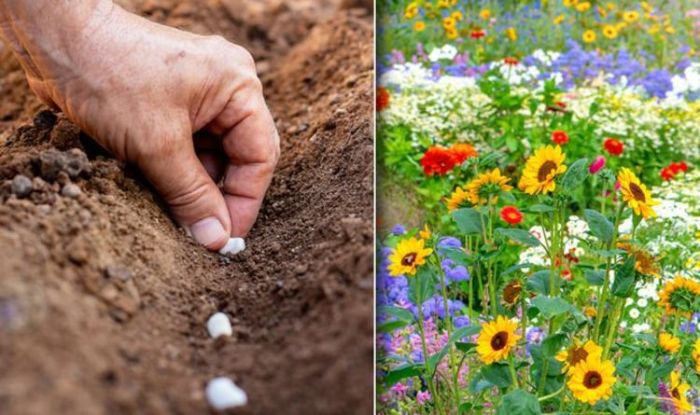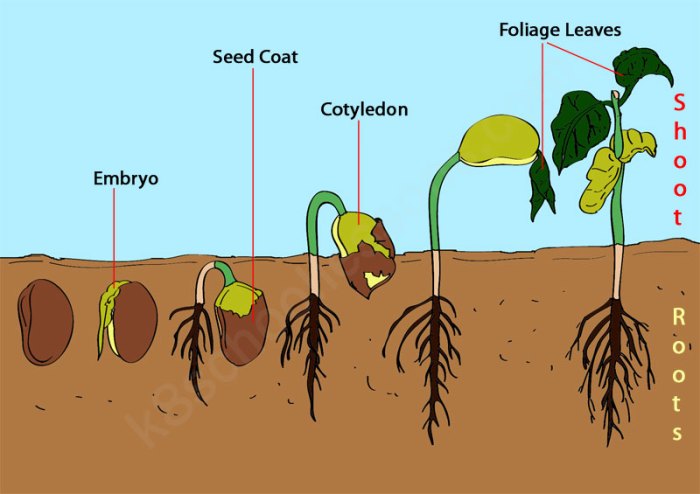How to Plant Seeds A Comprehensive Guide
Choosing the Right Seeds
How to plant seed – Selecting the right seeds is crucial for successful gardening. Consider factors like seed variety, climate suitability, and germination rate to maximize your chances of a bountiful harvest. Choosing seeds appropriate for your local climate and soil conditions is paramount; selecting a variety known for its resilience in your area will significantly improve your chances of success.
Seed Variety, Climate Suitability, and Germination Rate

Source: co.uk
Different seed varieties possess unique characteristics. Some are better suited to specific climates, while others exhibit higher germination rates. Researching your desired plant and choosing a variety that thrives in your local conditions is vital. Germination rate, the percentage of seeds that successfully sprout, is another critical factor to consider; higher germination rates reduce wasted seeds and effort.
Comparison of Seed Types and Growing Conditions
| Seed Type | Ideal Climate | Soil Type | Germination Time |
|---|---|---|---|
| Tomato | Warm, sunny | Well-drained, fertile | 7-14 days |
| Lettuce | Cool, sunny to partial shade | Moist, fertile | 3-7 days |
| Beans | Warm, sunny | Well-drained, fertile | 7-14 days |
| Zucchini | Warm, sunny | Well-drained, fertile | 5-10 days |
Seed Viability and Testing
Seed viability refers to a seed’s ability to germinate and grow into a healthy plant. Several methods can assess seed viability. A simple test involves placing a few seeds in a moist paper towel, then observing them for signs of germination over a few days. Seeds that don’t show signs of sprouting within a reasonable timeframe are likely non-viable.
Preparing the Soil
Proper soil preparation is essential for successful seed germination. The ideal soil is well-draining, aerated, and rich in organic matter. Improving poor soil quality can involve amending it with compost, adjusting its pH, and ensuring proper drainage.
Ideal Soil Composition and Improvement
A well-balanced soil mix provides the necessary nutrients and structure for optimal seed germination. The ideal soil should be loose and crumbly, allowing for good aeration and water penetration. Amending heavy clay soils with organic matter like compost improves drainage and aeration. Conversely, sandy soils benefit from the addition of organic matter to improve water retention. Soil pH should be tested and adjusted using lime (to raise pH) or sulfur (to lower pH) as needed, depending on the specific requirements of the plants you intend to grow.
Soil Drainage and Aeration
Good drainage prevents waterlogging, which can suffocate seeds and seedlings. Aeration ensures that the roots have access to sufficient oxygen. Loose, well-structured soil promotes both drainage and aeration. Adding organic matter like compost or peat moss significantly improves both.
Step-by-Step Guide for Preparing a Seed Starting Mix
- Combine equal parts of peat moss, vermiculite, and perlite in a large container.
- Add a slow-release fertilizer, following the package directions.
- Mix thoroughly until evenly distributed.
- Moisten the mix with water until it’s evenly damp but not soggy.
Sowing the Seeds: How To Plant Seed

Source: k8schoollessons.com
Correct sowing techniques ensure successful germination. Factors like planting depth and spacing vary depending on the seed type. Common mistakes include planting seeds too deep or too close together, leading to poor germination and stunted growth.
Correct Planting Depth and Spacing
Planting depth should be generally 2-3 times the seed diameter. Spacing should allow for adequate growth without overcrowding. Refer to seed packets for specific recommendations on depth and spacing for different plant types.
Common Mistakes and How to Avoid Them
- Planting seeds too deep: Leads to difficulty in germination.
- Planting seeds too close together: Causes overcrowding and competition for resources.
- Not watering adequately: Results in insufficient moisture for germination.
Different Sowing Methods
- Direct sowing: Planting seeds directly into the garden bed.
- Starting seeds indoors: Germinating seeds in containers indoors before transplanting outdoors.
Comparison of Direct Sowing vs. Starting Seeds Indoors
| Method | Advantages | Disadvantages |
|---|---|---|
| Direct Sowing | Less work, avoids transplant shock | Slower germination, susceptible to weather conditions |
| Starting Seeds Indoors | Faster germination, better control over conditions | More work, risk of transplant shock |
Providing Optimal Growing Conditions
Sunlight, water, and temperature are crucial for seed germination and seedling growth. A consistent watering schedule, appropriate sunlight exposure, and maintaining optimal temperatures are key to healthy seedlings.
Importance of Sunlight, Water, and Temperature
Seedlings require adequate sunlight for photosynthesis. Water provides essential moisture for germination and growth. Temperature affects germination rates and overall plant health. Most seeds germinate best within a specific temperature range; this information is typically found on seed packets.
Watering Schedule for Seedlings
A consistent watering schedule is crucial. Overwatering can lead to root rot, while underwatering can stunt growth. The frequency of watering depends on the type of plant, soil type, and environmental conditions. It’s often best to water deeply but less frequently, encouraging deeper root growth.
Watering Methods
Top watering involves watering from the top, while bottom watering involves watering from the bottom of the container. Top watering is simpler but can lead to soil crusting, while bottom watering is more efficient but requires more attention.
Protecting Seedlings from Pests and Diseases
Seedlings are vulnerable to pests and diseases. Regular inspection and prompt action are crucial. Methods include using organic pest control, ensuring good air circulation, and practicing crop rotation to minimize disease risk.
Transplanting Seedlings
Hardening off seedlings gradually acclimates them to outdoor conditions before transplanting. Proper transplanting techniques minimize root damage and transplant shock, ensuring a smooth transition from indoors to the garden.
Hardening Off Seedlings
Gradually expose seedlings to outdoor conditions over several days before transplanting. Start with a few hours of direct sunlight and gradually increase the exposure time each day.
Correct Transplanting Technique, How to plant seed
Handle seedlings gently to avoid damaging the roots. Water thoroughly before transplanting to make the process easier. Plant at the same depth as they were growing in their containers.
Step-by-Step Guide for Transplanting
- Gently remove the seedling from its container.
- Prepare a hole slightly larger than the root ball.
- Place the seedling in the hole, ensuring the top of the root ball is level with the soil surface.
- Fill the hole with soil and gently firm it around the plant.
- Water thoroughly.
Minimizing Transplant Shock
Water well before and after transplanting. Shade seedlings for a few days to allow them to adjust to the new environment. Avoid transplanting during extreme weather conditions.
Illustrating Seed Germination
Seed germination is a complex process involving several stages. Understanding these stages can help you identify potential problems and optimize growing conditions.
Stages of Seed Germination
Imbibition: The seed absorbs water, causing it to swell and activate enzymes. [Image description: A dry seed absorbs water, swelling visibly.] Radicle Emergence: The embryonic root emerges from the seed, anchoring the plant and seeking water and nutrients. [Image description: A small root emerges from the seed coat.] Plumule Emergence: The shoot emerges from the seed, growing towards the light.
[Image description: A small sprout pushes its way out of the seed coat and grows upwards.] Seedling Growth: The seedling develops leaves and begins photosynthesis. [Image description: A small plant with a few leaves emerges, growing taller.]
The seed’s internal structure undergoes significant changes during germination. The endosperm, which provides nourishment, is broken down and utilized by the growing embryo. The embryo itself develops, with the radicle and plumule growing rapidly. [Image description: A cross-section of a seed showing the endosperm, embryo, and seed coat. Arrows indicate the direction of growth during germination.]
Answers to Common Questions
What is the best time of year to plant seeds?
The ideal planting time depends on the specific plant and your local climate. Check seed packets for recommended planting dates or consult a gardening calendar for your region.
How often should I water my seedlings?
Water seedlings regularly, keeping the soil consistently moist but not waterlogged. The frequency will depend on factors like weather conditions and the type of plant.
What should I do if my seedlings are leggy?
Leggy seedlings indicate insufficient light. Move them closer to a light source or increase the duration of light exposure.
Planting seeds successfully involves understanding the specific needs of each plant. For instance, the process differs significantly depending on the species; learning how to handle delicate bulbs like amaryllis requires a different approach. To gain a deeper understanding of this, you might find the guide on how to plant amaryllis seeds helpful. This knowledge will then broaden your understanding of seed planting techniques in general, ultimately leading to a higher success rate with various plants.
How can I prevent damping-off disease in seedlings?
Ensure good air circulation, avoid overwatering, and use a sterile seed-starting mix to minimize the risk of damping-off.





















